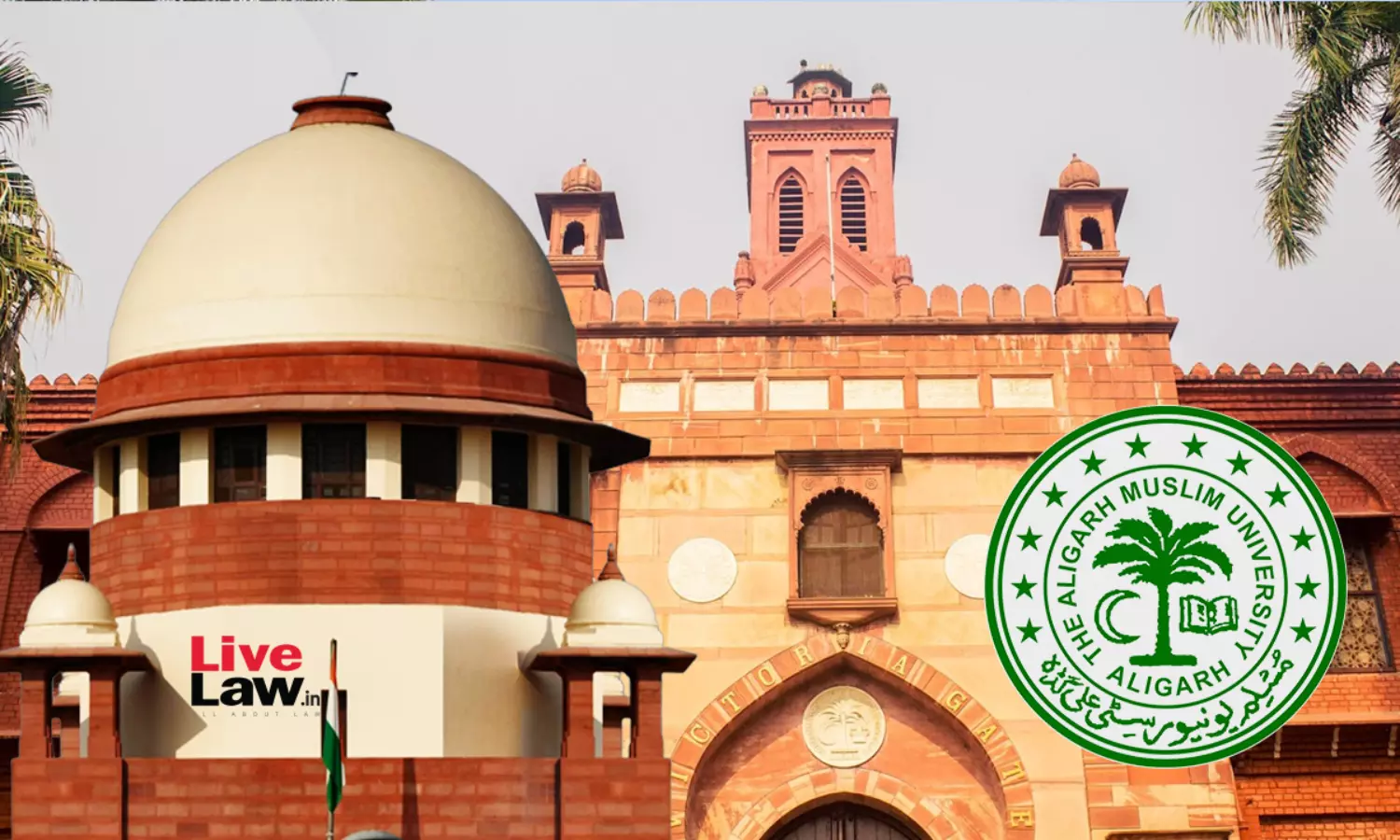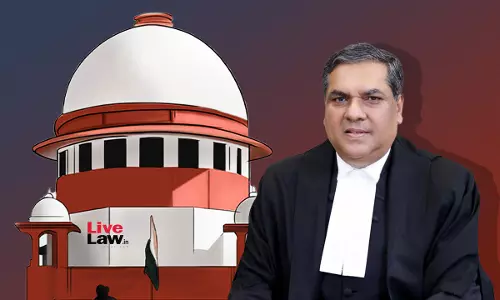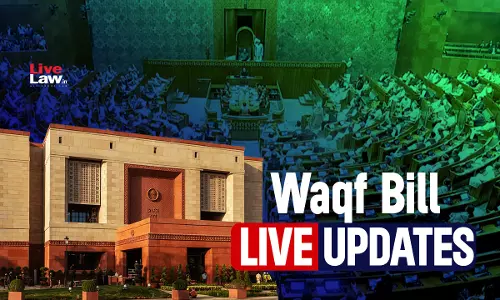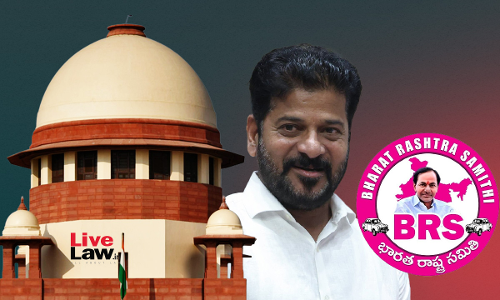Explainer | Aligarh Muslim University Minority Status Case : Issues & Arguments In Supreme Court

A Constitution Bench of the Supreme Court has reserved judgment on the case concerning the minority status of the Aligarh Muslim University (AMU).Being recognised constitutionally as an “Institution of National Importance” under Entry 63 of List I, AMU is the only one of the two educational institutions (the other being Benaras Hindu University) which has been bestowed this title. Founded...
A Constitution Bench of the Supreme Court has reserved judgment on the case concerning the minority status of the Aligarh Muslim University (AMU).
Being recognised constitutionally as an “Institution of National Importance” under Entry 63 of List I, AMU is the only one of the two educational institutions (the other being Benaras Hindu University) which has been bestowed this title. Founded in 1920 through the AMU Act, the university's founding history can be considered in three phases : (1) from 1870-1877, the genesis of the idea of setting up a university for the Muslim community came into the picture, the Muhammadin Anglo-Oriental (MAO) college was established; (2) 1877-1910 the Muslim community rallied to convert the MAO and the government under pressure agreed to convert the college and (3) 1910-1920, where the founders of the Muslim university actively engaged and succeeded in their desire to convert and incorporate the MAO into the present AMU.
The issue of granting 'minority status' to AMU under Article 30 of the Constitution has had a chequered history. In this article, we attempt to simplify the litigation history, legal nuances and Courtroom observations across time periods.
What is 'Minority Status'?
Article 30 of the Indian Constitution provides certain rights to religious and linguistic minorities in India. This article specifically deals with the right of minorities to establish and administer educational institutions. Under the fundamental right, such minority institutions can make reservations in their admission policies for the betterment of member belonging to their community.
The provision strives to give assurance of protecting their minority character. It aims to uphold the cultural and educational autonomy of minority institutions while allowing for reasonable regulations by the state in matters of education.
The Legal Antecedents That Paved the Way For Reference To The 7 Judges Bench
I. Azeez Basha v. Union of India - The Genesis of the Conundrum
In 1967, the Supreme Court of India had in question pertaining to the changes brought into the Orginal AMU Act by the amendments made through the 1951 and 1965 Amendment Act held that AMU was a non-minority institution.
The bench of the CJI KN Wanchoo and Justices RS Bachawat, V. Ramaswami, GK Mitter and KS Hegde took into account the historical antecedents of the formation of the university and held that while the founder of AMU was a Muslim leader, it cannot be said that AMU was established and administered by a minority under Article 30. The reason given for holding so was an emphasis on the fact that the University was established under a Pre-Constitutional Statute and was thus established by a Statute and not a minority community.
II. Coming of the 1981 Amendment Act
The AMU Act of 1920 came under the amendment for the 4th time in 1981. Three key changes were brought in to the legislation, firstly, Section 2(1) of the 1981 Act redefined the expressed “University” to mean an Institution “ Established by the Muslims of India”; secondly, Section 5 of the Amendment Act was modified to include “ Educational and Cultural Advancement of Muslims in India” within the foundational purposes of the Institution; and thirdly, removal of the term “ Establish and” from the Preamble of the 1920 Act.
These changes were introduced in light of the recommendations made by the Beg Committee and the Minorities Commission of India.
These changes had the effect of giving minority status to the AMU, diluting the judgment in Azeez Basha.
III. AMU v. Malay Shukla - The Allahabad High Court Judgement of 2006
The Allahabad High Court was deliberating on a legal challenge to the reservation policy for Muslim candidates. This policy involved allocating 50% of post-graduate course seats, originally designated for qualified MBBS doctors, by the University. The University argued that the Aligarh Muslim University (Amendment Act 1981) altered the foundation established by the Basha Judgment. However, the single bench concluded that the University does not qualify as a minority institution.
Affirming the decision of the Single bench, the division bench of the Allahabad High Court determined that, despite being founded by a minority, if it was never administered or claimed to be administered as such, it cannot be designated as a minority institution.
The HC held : (a) relying upon the ratio in Basha, the AMU continues to be a non-minority institution and cannot claim otherwise under Article 30; (b) S. 2 (1) and 5(2)(c) of the 1981 Act are considered invalid; (c) The removal of the words ''establish and' from the preamble of the 1920 Act by the 1981 Act is invalid and those words are restored to the preamble; (d) claim of the 50% Muslim quota for PGC declared unconstitutional for all and future purposes; (e) The Union's communication dated 25.2.2005 vetting the purported minority status of the Aligarh Muslim University by permitting their claim of Muslim reservation is quashed and set aside.
IV. Formation of the Constitution Bench
The 7 judge bench was formed as a consequence to a reference order of 2019 passed by a 3 judge bench headed by the then CJI Ranjan Gogoi. The reference occurred while hearing an appeal against the 2006 Allahabad High Court's Judgement.
One can say that the matter has been re-referred. Considering the Apex Court's past two attempts at deliberating upon the issue. Between the 1967 Supreme Court ruling and the 2006 Allahabad High Court judgment, there is a Supreme Court directive from 1981 (in Anjuman-e-Rahmania Vs. District Inspector of School), where the matter addressed in the Basha Judgment was forwarded to a Seven Judges Bench. The referred question was as follows :
"What are the indicia for treating an educational institution as a minority educational institution? Would an institution be regarded as a minority educational institution because it was established by a person(s) belonging to a religious or linguistic minority or its being administered by a person(s) belonging to a religious or linguistic minority?"
While the mentioned reference was considered by an 11-judge bench along with T.M.A. Pai Foundation vs. State of Karnataka, the Bench opted not to address the question, stating that it would be handled by the Regular Bench. Subsequently, the regular bench also refrained from providing an answer to the said question.
The final constitution of the reference bench this year comprised Chief Justice Of India, DY Chandrachud and Justices Sanjiv Khanna, Surya Kant, JB Pardiwala, Dipankar Datta, Manoj Misra and SC Sharma. Representing AMU and the AMU Old Boys' Association, were Senior Advocates Dr Rajeev Dhavan and Mr Kapil Sibal along with Mr Salman Khurshid, Mr Shadan Farasat who appeared on behalf of intervenors.
The Union of India was represented by the Attorney General Mr R Venkataramani as well as the Solicitor General Mr Tushar Mehta. Several other senior advocates including Mr Neeraj Kishan Kaul, Mr. Guru Krishna Kumar, Mr Vinay Navare, Mr. Yatinder Singh, Mr. Vikramjit Banerjee (ASG) and Mr KM Nataraj (ASG) also appeared to advance arguments on behalf of respondents and intervenors.
Arguments Raised Before the Constitution Bench
During the hearings before the Constitution Bench, spanning eight days, a series of arguments were presented by the petitioners and counterarguments were offered by the Centre.
1. On the Correctness of Azeez Basha v. Union of India
Petitioners' Argument: There exists 4 key facets of concern in the ratio of Basha. Firstly, the ruling acknowledges the possibility of universities being recognized as minorities. Secondly, it highlights the historical background and the significant role played by Muhammandan Anglo-Oriental College (MAO) in the establishment of the institution, categorizing it as distinctly Muslim. Thirdly, the court neglects the intended purpose outlined in the AMU Act 1920, which serves as the founding legislation for the University. Fourthly, the judgment overlooks alternative interpretations of 'Establish' and incorrectly downplays the significance of 'Recognition'.
On one hand, the Court, in its Basha judgment, appropriately acknowledges the Muslim identity of AMU, but on the other hand, it refutes its constitutional status. This contradicts the stance taken by the Supreme Court in the St. Stephens College v. University of Delhi case, where the court upheld the college's minority status under Article 30(1) due to its Christian character, allowing it to implement a 10% reservation for Christian students, contrary to the University circulars.
Centre's Counter: The Basha decision specifically pertains to the 1920 Act and does not establish a universally applicable precedent that a university loses its minority status once incorporated. According to the Union's perspective, Basha solely scrutinized the provisions of the 1920 Act and concluded that AMU, in particular, does not qualify as a minority university.
2. On the Twin Test of Establish and Administer Under Article 30
Petitioners' Argument: Article 30 does not necessitate the mandatory proof for a minority community to establish and directly administer an educational institution. Article 30 grants the right to administer an institution, but this administration should be viewed in a dynamic context. In this context, the community establishing the institution may choose to delegate its administrative powers to a non-minority entity.
For the Petitioners, the 5 indicia of administration in an educational institution, in the constitutional essence would include: (a) to admit students; (b) to set up a reasonable fee structure; (c) to constitute a governing body; (d) to appoint staff (teaching and non-teaching); and (e) to take action if there is dereliction of duty on the part of any employees. The notion that fulfilment of the Article 30 claim requires exclusive representation of the minority community in the administration is inaccurate. Administration under Article 30 was granted to minority communities as a matter of 'right' and not a strict obligation.
Centre's Counter: Article 30 mandates twin conditions to be fulfilled. The institution should be both established and administered by the said community. For AMU to be recognized as a minority institution, the administration must be predominantly under the control of the minority groups, with only a minor presence of non-minorities. Nevertheless, according to the provisions of the AMU Act, of 1920, this condition does not seem to be met. As per the Scheme of the original Act, major decision-making powers were bestowed with the Lord Rector/Governor-General under Section 30, through whom the British Crown ruled in India.
3. On the Concept of 'Minority' Before and After the Coming of The Constitution
Petitioners' Argument: The concept of minority was quintessential during and after our freedom struggle. Even before the enactment of the Constitution, the notion of minority status and protection of the minority community manifested itself in Indian society as well as the law. This could be illustrated by a variety of Pre-Independence Electoral Acts such as the Act of 1909 (Minto-Morely Reforms), the 1919 Government of India Act and the Government of India Act 1935, which contained provisions reserving specific seats in the electoral frameworks for the then recognised minorities which included Muslims and Sikhs. the sociological factors underplaying the communal atmosphere before and after the Independence of India were a manifest recognition of 'Minority Character' in the society. The protection of Article 30 was available even to the institutions which were established before the Constitution.
Respondents' Counter: There existed no concept of 'Minority' before the advent of the Constitution. minority as a concept has to be seen from the lens of political relationships that were maintained in the British Era and the Post-British Era. Article 30 encapsulates the political dynamics in a society when dealing with the idea of a minority. In the era of British rule, the concept of 'minority' did not exist, and Hindus and Muslims experienced equal hardships under British governance. Furthermore, Muslims outnumbered the ruling Christians (British) numerically. Additionally, the founders of AMU, led by Sir Syed Ahmed Khan, were loyal to the British empire, indicating that qualitatively, there was no subordination to the ruling group to categorize this community as a 'minority.'
4. On Political Inclination of AMU Founders As A Consideration To Decide Minority Status
Petitioners' Argument: The political inclination or allegiance of the Founders of AMU had no bearing on deciding the question of the constitutional interpretation of Article 30. It was submitted that in the freedom movement, many Indians were either employed by the British Crown or pursuing a significantly different path, as seen with figures like Netaji Subhas Chandra Bose. However, this did not sever their allegiance to their country. In doing so, the Court would end up applying a test which may be constitutionally suspect. To determine the status of an educational institution solely on the basis of the political stand during the pre-independence times would be divisive.
Centre's Counter: The founders of AMU relinquished their minority privileges to the Imperial Regime, a move not mirrored by other institutions. It was stressed that AMU surrendered its rights to the British crown, thus disqualifying itself from claiming minority status. This rationale was elucidated in the 1967 Azeez Basha judgment, which ruled that AMU was not a minority institution. While AMU existed as a pre-constitution institution acknowledged under Imperial legislation, there were other contemporaneous institutions, such as Osmania University, Bihar University, Kashi Vidhyalaya, Scottish College, and St. Stephen's, which were not formally recognized under the British Crown. The founders of the AMU were considered 'loyalists' to the Imperial regime.
In 'The Loyal Musalman,' authored by AMU's founder, Sir Syed Ahmad Khan, it is evident that the primary objective of MAO (Muhammadan Anglo-Oriental College, later becoming AMU) was to establish an educated Muslim class characterized by loyalty to the ruling authority.
5. On Whether An Institution of National Importance Could Be Conferred Minority Status
Petitioners' Argument: As per Entry 63 of List 1 of the Constitution, institutions such as the AMU, Benaras Hindu University, Delhi University etc., are declared to the institutions of national importance. It was argued that the entries in the seventh schedule exclusively pertain to determining the authority of the Union and State Governments over different subjects. It's important to note that these entries do not have the power to restrict fundamental rights. The significance of a Fundamental Right, such as the one outlined in Article 30, cannot be obstructed or diminished by the Schedules appended to the Constitution. Article 30 could not be read out of existence at the behest of List I which merely decided the issue of law-making competence.
Centre's Counter: The challenge to the minority status of AMU in the Allahabad High Court arose following the 2005 Constitution Amendment, incorporating Article 15(5) to enforce reservations for SC/ST/OBC in higher educational institutions. As minority institutions were exempt from Article 15(5), the Centre aimed to assert that AMU should be deemed a non-minority institution. Thus AMU being an Institution of National Importance should therefore reflect the national structure, especially from the lens of social justice. The court should employ a more rigorous examination to designate an institution as a minority institution, given that such a classification would lead to the exclusion of SC/ST/ OBC reservations. The Supreme Court has affirmed these reservations as an integral aspect of equality. Furthermore, being of 'National Importance', AMU gets substantial funding from the centre to maintain its academic excellence. Giving the University a minority status would deprive it of its substantial funding.
6. On The Nature, Effect & Fate of the 1981 Amendment Act
Petitioners' Argument: The petitioner submitted that to comprehend the Parliament's intent behind enacting the mentioned Amendment, one must consider the comprehensive scheme and purpose underlying the Amendment. The resemblances between the 1920 Act and the 1981 Amendment indicate a clear and sincere intention in the latter to foster the educational and cultural progress of Muslims, specifically. The effect of the 1981 Act was to statutorily recognise the historical antecedents and the fact that AMU was established by the minority community and not merely by a Statute, thus taking away the reasoning in the Basha Judgement. In regards to the event that the Court decides on the correctness or incorrectness of Basha, it was submitted that the 1981 Amendment Act only reaffirmed that AMU was a minority institution. If the Court gives a declaration on the minority status of AMU, the 1981 amendment becomes insignificant.
Centre's Counter: The respondents submitted that the 1981 Amendment did not take away the basis of Basha and perhaps was only a legislative fiat which could not take away the historical antecedents of AMU being established under an Imperial Statute. Thus the centre in its official stand as per the affidavit supported the Allahabad High Court Judgement which struck down the major changes brought in by the 1981 Act.
From The Bench: Key Points Of Obersvation During Hearings
1. Multiple Facets of Article 30
The bench observed that the expression 'Establish' or 'Establishment' is rooted in the founding moment in time, whereas 'Administer' meant something which is a continuing exercise and doesn't fix itself to a specific moment in the past. The expression 'Of their Choice' implies that a minority community not only has the option to establish an institution but also the freedom to designate another entity for its administration, without jeopardizing the minority status of the institution.
2. Constitutional Rights cannot be Subservient to Statutory Rights -
In light of the argument made by the centre that the rights under Article 30 could only be realised by an enabling provision or statutory framework, the CJI remarked it would be overboard to assert that the right to establish a minority institution is solely contingent upon recognition by an enabling legislation. This would lead to a vague conclusion that a constitutional right can be overlooked by a statutory right.
3. Parliament's Unfettered Law-Making Power -
Time and again when the Centre submitted their non-acceptance of the 1981 Amendment, the CJI would caution the counsels not to make arguments which may hinder the unfettered law-making powers of the Parliament. Especially so when it is within the legislature's domain to take a certain view while dealing with terms like 'established' within the Act. the CJI stressed that one cannot argue to the extent of diluting the powers of the Parliament and the amendments that it can make. According to the CJI, The Parliament is an indestructible, indivisible and continuous entity.
4. Establishment Under Imperial Statute Doesn't Indicate Surrender of Minority Status -
The historical context in which the AMU Act came into existence and the founding purpose of the legislation has to be seen while keeping in mind that during the British Raj, all regulatory frameworks were created to ensure that nothing overpowers the imperial hegemony. CJI opined that the surrendering of rights by the Founders of the AMU has been interpreted in the strictest sense possible.
The 8 days long hearing finally culminated on February 1, 2024, with the Supreme Court reserving the judgement.
Reports of hearings :




